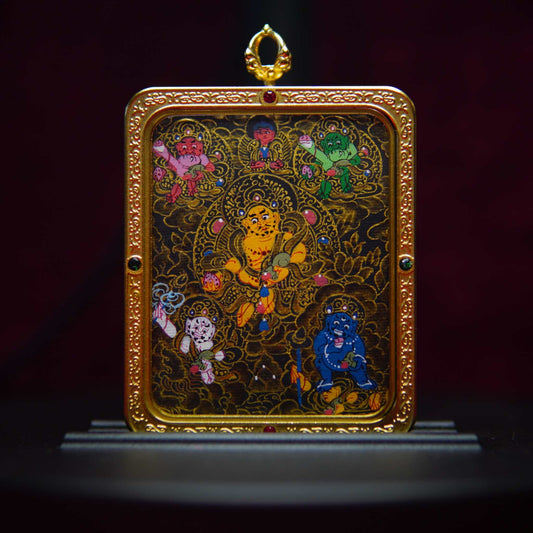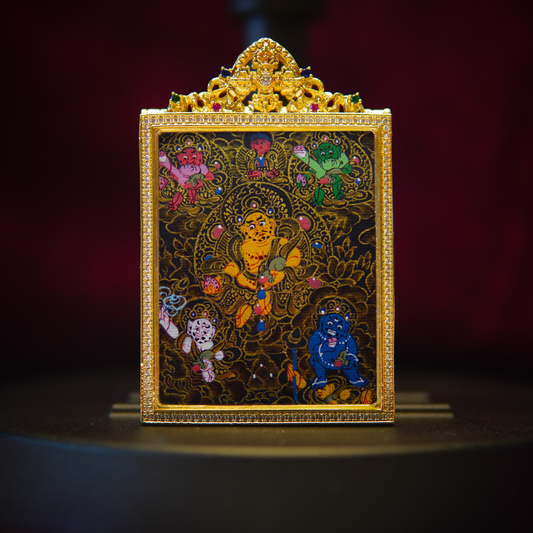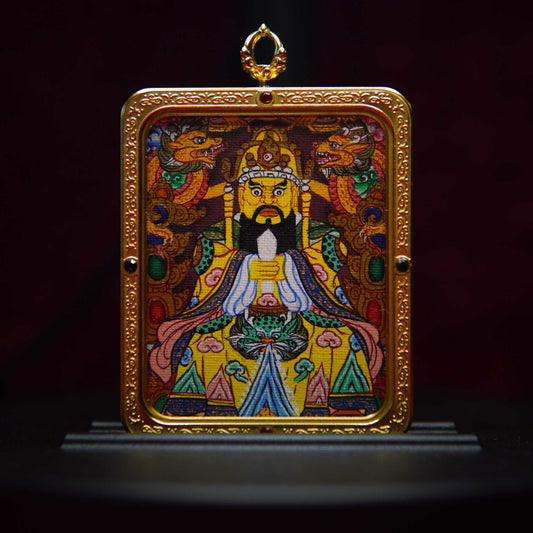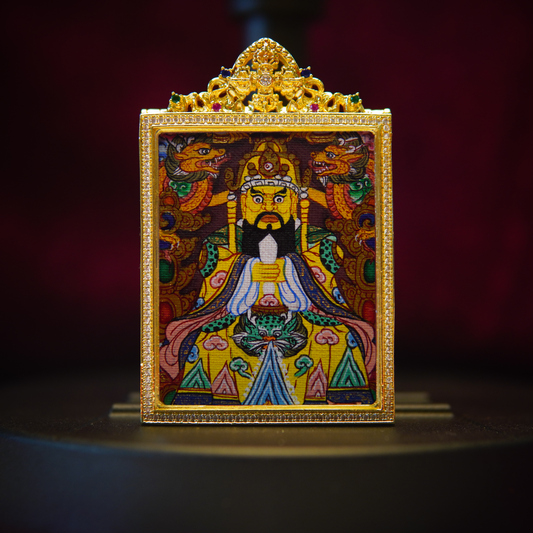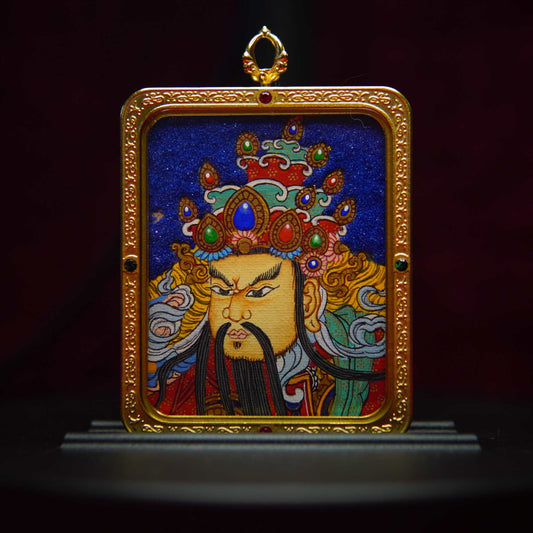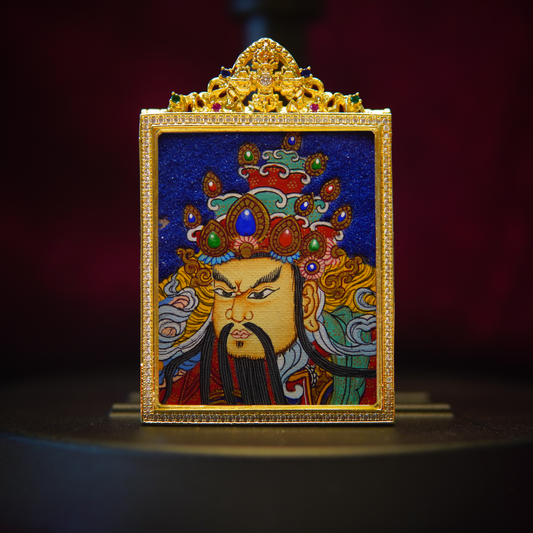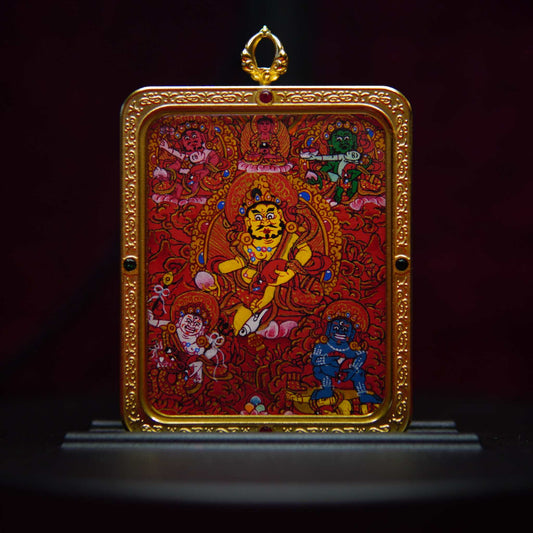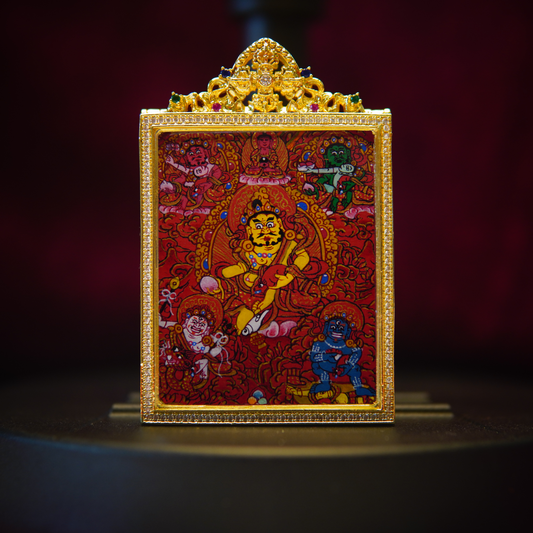The Liberation Hat of Pema Jungne: A Tale of Fire, Devotion, and Transcendence
Tapita- The Liberation Hat of Pema Jungne: A Tale of Fire, Devotion, and Transcendence
- Introduction: The Crown That Liberates Upon Sight
- The Kingdom of Sahor: A Land Not Yet Turned Toward Dharma
- The Cave of Longevity: Where Wisdom Met Resistance
- The Fire Trial: A Crowned Master Is Born
- Repentance and Royal Surrender
- The Symbolism of the Liberation Hat
- A Living Sacred Site: Lotus Lake Today
- Conclusion: The Crown That Frees the Mind
Introduction: The Crown That Liberates Upon Sight
In almost every thangka depiction of Pema Jungne—the great Indian master who brought Vajrayana Buddhism to Tibet—you’ll notice an elaborate, pointed hat on his head. This is no ordinary crown. It is called the "Liberation Upon Seeing Hat", or “Thongdrol Zha” in Tibetan. The very sight of it is believed to plant seeds of liberation in the minds of sentient beings.
But where does this sacred symbol come from? What deeper truth lies beneath its royal shape and mystical reputation?
To uncover its origin, we must travel back to ancient India—to a kingdom of skeptics, a blazing fire, and a miracle that would forever change the course of Buddhist history.
The Kingdom of Sahor: A Land Not Yet Turned Toward Dharma
Long ago, in a region of northwestern India, there existed a powerful kingdom known as Sahor. The people of Sahor followed Sikhism and other indigenous traditions—not Buddhism. It was a place of pride, tradition, and deeply entrenched beliefs.
When Pema Jungne arrived in Sahor to teach the Dharma, he faced resistance. However, his spiritual magnetism, immense compassion, and display of supernatural siddhis (powers) soon began to draw attention. Among the first to open her heart to his teachings was none other than Princess Mandarava, the daughter of the King of Sahor.
The Cave of Longevity: Where Wisdom Met Resistance
In the mountains near Sahor lies a sacred site now known as the Cave of Longevity. It was here that Pema Jungne and Mandarava entered deep retreat. Within the cave, they meditated and engaged in profound teachings of the Vajrayana path, drawing disciples and seekers who began to see the light of Dharma for the first time.
Yet, perception is shaped by karma. While some witnessed a field of pure teachings and sublime transmissions, others—blinded by doubt—saw only worldly interaction. Rumors began to spread: that the foreign monk had seduced the princess, that he was a fugitive from another kingdom, and that his so-called miracles were illusions.
These whispers reached the ears of the King.
The Fire Trial: A Crowned Master Is Born
Infuriated and misled, the King ordered the execution of Pema Jungne. He summoned his royal guard and declared that the “outsider” should be burned alive in a public ritual, to cleanse the kingdom of deception.
On a vast plain, in what is now believed to be the area of Lotus Lake in present-day Nepal, mountains of wood and barrels of oil were gathered. Pema Jungne was tied to a central stake, drenched in oil, and the fire was lit.
The blaze raged for seven days and nights.
On the seventh day, the King and his court arrived to inspect the ashes. But what they saw shattered their reality.
Where there should have been a charred corpse, there was instead a clear, serene lake, filled with blooming lotus flowers. In the center of the lake rose a towering lotus stem, and atop it sat Pema Jungne, reborn as a radiant 16-year-old youth, glowing with health and divine majesty. Completely unharmed, he sat naked, luminous, and utterly at peace, on a lotus throne.
Repentance and Royal Surrender
Witnessing this divine transformation, the King was overcome with awe, shame, and deep reverence. He fell to his knees, wept, and confessed his wrongdoing. As a sign of repentance and offering, he removed his own royal crown, garments, and ornaments, and offered them to Pema Jungne.
He said:
“Please, great master, accept my kingdom, my people, and even my body, speech, and mind. Let this be the offering to purify my ignorance and transgression.”
Pema Jungne accepted. From that moment on, the Liberation Hat became both a symbol of forgiveness and a sacred transmission of royal authority in service of the Dharma.
The Symbolism of the Liberation Hat
Today, this iconic hat worn by Pema Jungne in thangka paintings is directly inspired by the King of Sahor’s crown. But it is more than ornamental:
The tapered peak pointing forward symbolizes spiritual focus and direct path to realization.
The flower-like lotus motif at the front reflects purity born from the mud of worldly suffering.
The hat is often surrounded by silk streamers or peacock feathers, representing fearlessness and mastery over samsara.
In Sahor, local men still wear similar hats today—though theirs are flat-topped. Only the guru’s hat points forward, to signify his enlightened status and the miracle he manifested.
A Living Sacred Site: Lotus Lake Today
The lake where this miracle occurred still exists. Known by pilgrims as Lotus Lake, it is surrounded by lush trees, mysterious plants, and abundant lotus flowers.
On auspicious days—especially the 10th day of the Tibetan lunar month, sacred to Pema Jungne—devotees have reported extraordinary visions. Some claim to see Pema Jungne seated on the central lotus with their own eyes. Others witness rainbows arching over the water, or lotus blossoms gently revolving clockwise around the lake, like they are circumambulating a living Buddha.
Even local Sikh communities, whose ancestors shared this land, venerate Pema Jungne. In their oral histories and sacred texts, he is referred to respectfully as Guru Rinpoche, a “great Guru of miracles,” whose story echoes that preserved in Tibetan Buddhist lineage.
Conclusion: The Crown That Frees the Mind
The story of Pema Jungne’s Liberation Hat is more than myth—it is a living teaching. It reminds us that true realization cannot be burned, suppressed, or silenced. That faith, devotion, and pure perception have the power to transform the impossible into the miraculous.
For those who wear or meditate upon Pema Jungne’s image, the Liberation Hat is not just historical regalia—it is a beacon of awakening.
It tells us:
- Even fire cannot destroy truth
- Even hatred can become devotion.
- Even a crown meant to condemn can become a tool of liberation
May all beings who see, hear, or remember this story be blessed with swift liberation and boundless wisdom.
🪷 OM AH HUNG VAJRA GURU PADMA SIDDHI HUNG 🪷

